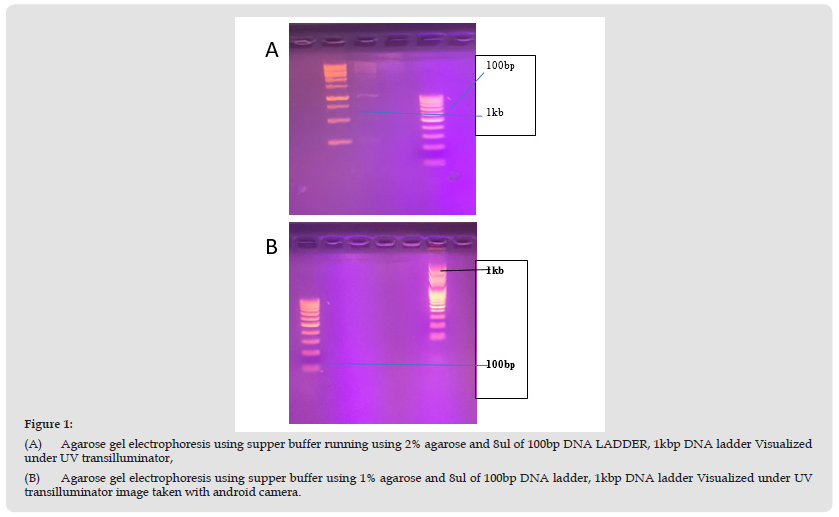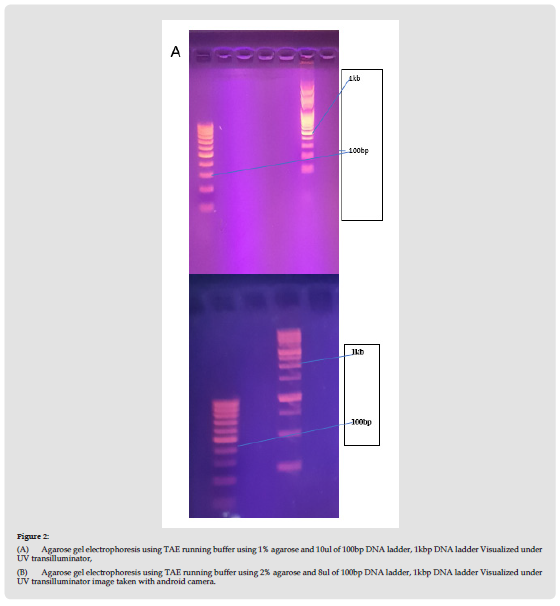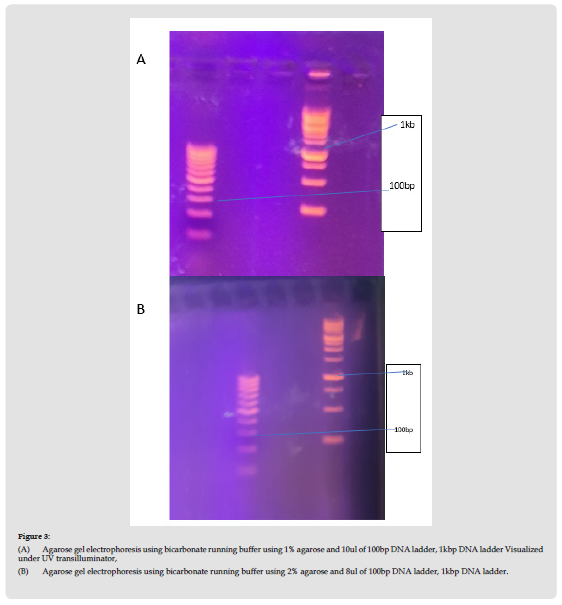Impact Factor : 0.548
- NLM ID: 101723284
- OCoLC: 999826537
- LCCN: 2017202541
Sahar Abd Al-Daim*
Received: March 20, 2023; Published: April 06, 2023
*Corresponding author: Sahar Abd Al-Daim, Water Pollution Research Department, Environment and Climate Change Institute, National Research Centre, 12622-Dokki, Cairo, Egypt
DOI: 10.26717/BJSTR.2023.49.007829
To detect the genome of viruses (in environmental and clinical samples), we use electrophoresis running buffer after PCR reaction. Also, electrophoresis buffers were used widely to separate any DNA molecule. In this paper we used four types of previously known electrophoresis buffers to compare which is easy for preparation, simple in structure, low cost and good performance in agarose gel electrophoresis. For this we used two agarose concentration (1%, 2%) and two types of DNA ladder (100bp, 1kb) represent both smaller and larger sizes of molecule for each type of buffers, from the result we found in first level both supper buffer and TAE buffer with good performance and in second level we found bicarbonate buffer also with good performance also. Finally, we found the tang buffer cannot pose any electrophoretic activity on DNA agarose gel electrophoresis.
Keywords: Electrophoresis Buffer; Agarose Gel; TAE Buffe; Supper Buffer
The most common technique for sorting, identifying, and purifying nucleic acid fragments is agarose gel electrophoresis. The performance of the electrophoresis could be impacted by the buffers’ composition, ionic strength, and pH characteristics [1]. DNA electrophoresis involves loading DNA samples into the wells of an agarose or acrylamide gel and subjecting them to an electric field. DNA fragments have a net negative charge; when subjected to an electric field, the negatively charged nucleic acid fragments migrate towards the positive electrode [1]. The length of DNA fragments is a primary factor that influences the rate of migration; shorter DNA fragments travel faster through the gel matrix than longer fragments. Therefore, DNA electrophoresis results in the separation of DNA fragments based on size [2]. The DNA ladder contains a mixture of DNA fragments of pre-determined sizes that can be compared against the unknown DNA samples(9). Tris–acetic acid (TAE) and Tris–boric acid–ethylenediaminetetraacetic acid (TBE in agarose gel electrophoresis, are two of the most common running buffers [3]. DNA gel electrophoresis is usually performed for analytical purposes, often after amplification of DNA via polymerase chain reaction (PCR), but may be used as a preparative technique prior to use of other methods such as mass spectrometry, Restriction fragment length polymorphism RFLP, polymerase chain reaction PCR, cloning, DNA sequencing, or Southern blotting for further characterization. There are many types of electrophoresis buffer that are less common and not used widely. However, they have good performance and are simple in preparation and more available reagent than the two most commonly used. In this paper we compare the TAE buffer and three other buffers that are less commonly used and give spotlight to the best one.
100bp DNA Ladder (NORGEN,cat# 11400,Canda) and 1kbp DNA ladder (GeneDirex,Cat.DM010-R500,Taiwan), agarose gel electrophoresis grade (iNtRoN,Cat.No.32033), five types of buffers:
1. Tris acetic acid buffer (TAE) [4],
2. Super buffer [5],
3. Tang buffer [6] and
4. A bicarbonate buffer system [7], ethidium bromide dye for agarose gel staining(2%), submarine electrophoresis (model: HB1214,RATED: 0-150V,0-100ma), UV transilluminator (SPECTROLINE,MODEL-TM-312A), electrophoresis power supply (CONSORT,3000v-300Ma,E833).
Preparation of reagents
a) 50x TAE buffer:
242 gram of tris base
57.1 gram of glacial acetic acid
100 ml of 0.5 M EDTA solution (PH8.0)
Adjust volume to one liter also working buffer should be diluted to 1x before use
b) 50 x supper buffer:
8 grams of NaOH
Peat
45 grams of boric acid
Up to 400 ml of distilled water the working concentration should be only 1x of previous mentioned 50x buffer by dilution.
c) Tang buffer:
Tang breakfast drink 8 gram in one liter
Adjust PH TO 7.5
d) Bicarbonate buffer system:
2gram sodium bicarbonate
0.05 Na CL
e) Up to 1 liter of distilled water: We make two different concentrations of agarose 1% and 2% for each type of electrophoresis buffer stained with 8ul ethidium bromide dye. Also, we must mention each electrophoresis buffer should use both for cooking of agarose side by side with running immersed buffer. After that we load 10 ul of both 100bp and 1kb DNA ladder as a model for DNA samples because they are only the available in the experiment time. We adjusted voltage of the power supply and leave DNA ladder to migrate through gel and observed the result under UV transilluminator. We load in each gel two lanes (100bp DNA,1KbDNA ladder) as two different DNA sizes to acted instead of large size and smaller one.
Figure (1) showed the agarose gel electrophoresis using supper buffer, Figure (2) showed the agarose gel electrophoresis using a TAE buffer and Figure (3) showed the agarose gel electrophoresis using a bicarbonate buffer, and we also use a fourth buffer called tang buffer, but it showed no observed result (Figures 1,2 & 3).
Figure 1 (A) Agarose gel electrophoresis using supper buffer running using 2% agarose and 8ul of 100bp DNA LADDER, 1kbp DNA ladder Visualized under UV transilluminator, (B) Agarose gel electrophoresis using supper buffer using 1% agarose and 8ul of 100bp DNA ladder, 1kbp DNA ladder Visualized under UV transilluminator image taken with android camera.

Figure 2 (A) Agarose gel electrophoresis using TAE running buffer using 1% agarose and 10ul of 100bp DNA ladder, 1kbp DNA ladder Visualized under UV transilluminator, (B) Agarose gel electrophoresis using TAE running buffer using 2% agarose and 8ul of 100bp DNA ladder, 1kbp DNA ladder Visualized under UV transilluminator image taken with android camera.

Figure 3 (A) Agarose gel electrophoresis using bicarbonate running buffer using 1% agarose and 10ul of 100bp DNA ladder, 1kbp DNA ladder Visualized under UV transilluminator, (B) Agarose gel electrophoresis using bicarbonate running buffer using 2% agarose and 8ul of 100bp DNA ladder, 1kbp DNA ladder.

Agarose gel electrophoresis has proven to be an efficient and effective way of separating nucleic acids. From the obtained result showed above through this study we found the most excellent electrophoresis buffer is supper buffer and I will use it in all my future research in viral detection. Advantage of the Super Buffer the voltage could reach up to 25 V/cm and electrophoresis could be performed within 10 min. It also produced less heat [5]. TAE buffer comes as second choice in this study because it consumes more time and chemicals and also multiple steps of preparation than that need for preparation of super buffer. bicarbonate buffer has good performance as electrophoresis buffer and low cost and simple preparation as much easy. Tang buffer comes out of my choice as electrophoreses buffer because they give no result permanently. The TAE buffer has a poorer buffering capacity and requires a longer electrophoresis duration, but it can produce the appropriate electrophoretic effect and is simple to store [8]. Moreover, super buffer offers the benefits of being straightforward to use, simple to prepare, and appropriate for big DNA fragments [5]. From the obtained result we can concluded that the most desirable electrophoresis buffer between four compared buffers in order to establish it as standard buffer in my lab is supper buffer. Because of In my specific research field (virology), I need large amount of electrophoresis buffer I need for it to make screening for a large number of environmental and clinical samples in order to detect different types of viruses. By using PCR technique which entirely followed by migration of PCR product in agarose, electrophoresis system. I recommend supper buffer side by side with side with TAE buffer and bicarbonate buffer as a second buffer for use in agarose gel electrophoresis buffer.
Depending on the commonly used buffer is not useful entirely we must search for good one, low cost and simple in preparation. From the present study, we can give green light to use super buffer in place of TAE or TBE buffers in agarose gel electrophoresis.


